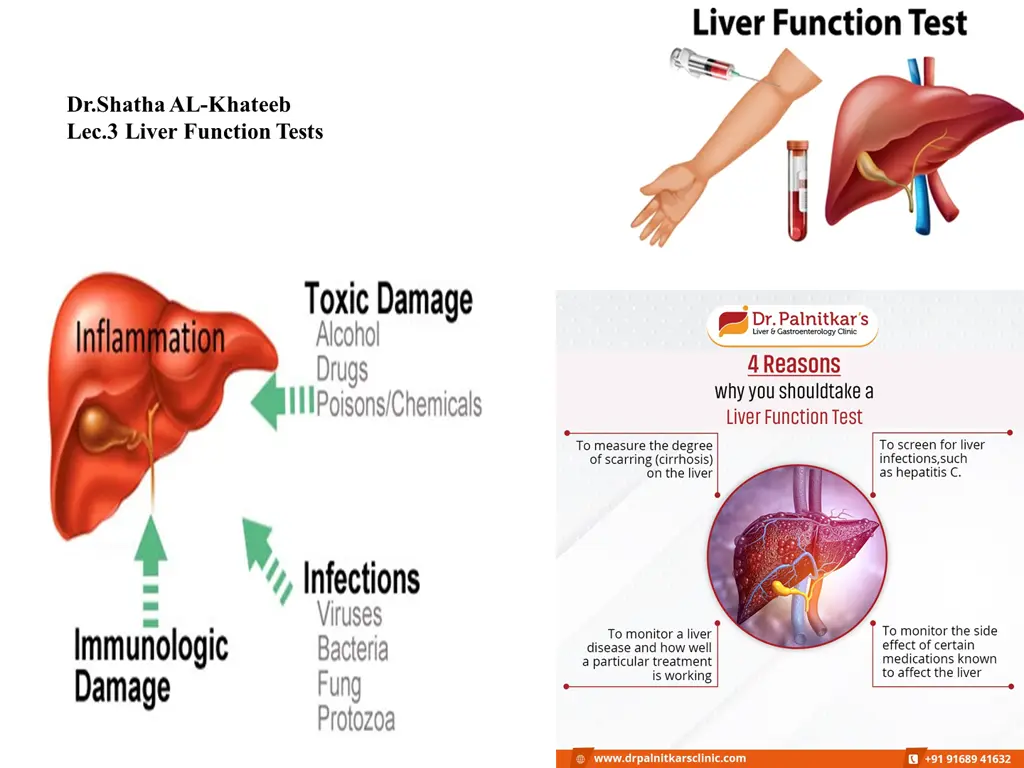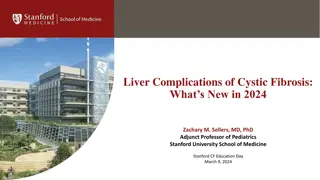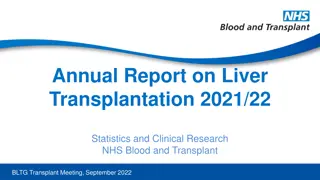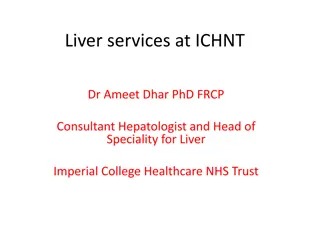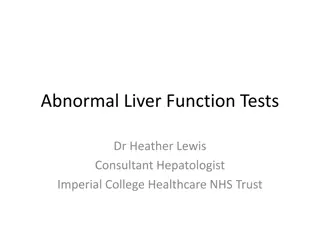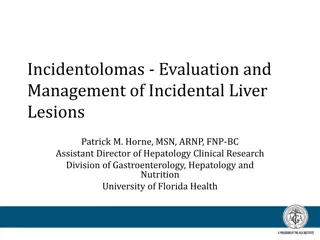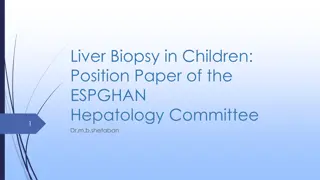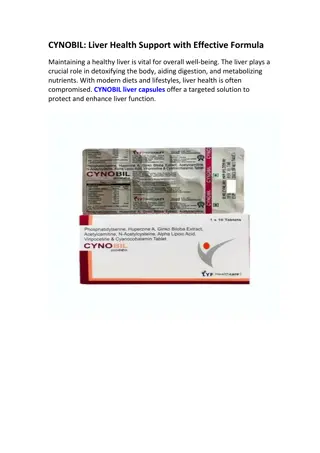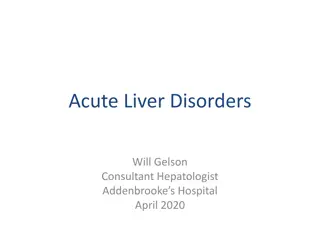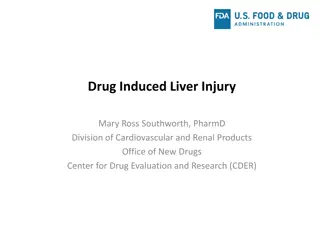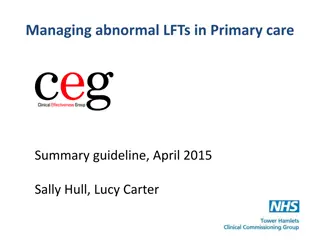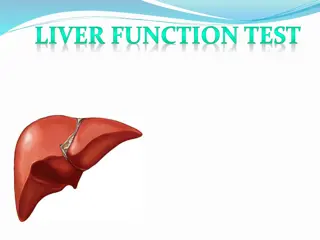Understanding Liver Function Tests in Cholestatic Injury
Cholestatic liver disease affects Alkaline Phosphatase (ALP) and bilirubin levels, indicating bile duct damage. GGT and 5'-Nucleotidase help differentiate hepatobiliary vs. bone origin of ALP elevation. ALP is produced by bile duct epithelium and can be normal in acute biliary obstruction. GGT and NTP are specific to hepatobiliary pathology. GGT is increased in biliary obstruction and liver diseases, while NTP catalyzes nucleotide cleavage in cells. Elevated GGT can signal liver issues from alcohol, drugs, jaundice, or liver tumors.
Download Presentation

Please find below an Image/Link to download the presentation.
The content on the website is provided AS IS for your information and personal use only. It may not be sold, licensed, or shared on other websites without obtaining consent from the author. Download presentation by click this link. If you encounter any issues during the download, it is possible that the publisher has removed the file from their server.
E N D
Presentation Transcript
Dr.Shatha AL-Khateeb Lec.3 Liver Function Tests
Tests of Cholestatic Injury Cholestatic liver disease is associated with elevated alkaline phosphatase with or without elevations in bilirubin. These elevations indicate damage to the bile ducts. ALP elevations are not specific for liver disease and additional tests may be needed to assess the source of the problem. GGT and or 5' Nucleotidase combined with an elevated alkaline phosphatase helps to differentiate between hepatobiliary origin vs bone origin. (If the GGT or 5 prime Nucleotidase are normal, then the origin is NOT for the liver). Alkaline phosphatase is an enzyme in the liver, cholestasis leads to a de novo increase in the production of this enzyme by the bile duct epithelium and the canalicular membrane of the hepatocytes, thus ALP levels may be normal in acute biliary obstruction and the elevation of the enzyme may not be seen until after a few days. Non-hepatic sources of ALP are bones, intestine and placenta.
GGT is also found in hepatocytes and bile duct epithelial cells. It is a very sensitive test of hepatobiliary disease (both hepatocellular and cholestatic injuries). Because GGT is not elevated in bone disease, it is mainly used to confirm the liver as the source of increased alkaline phosphatase. 5'-Nucleotidase (5'N) Although 5'N has a wide body distribution, its elevation is generally associated with hepatobiliary pathology. Like GGT, 5'N is not elevated in bone disease and it is therefore useful in confirming hepatic origin of alkaline phosphatase. Of note, the increase in 5'N may not parallel the increase in alkaline phosphatase. Bilirubin
Gamma Glutamyl Transferase (GGT) Is a transferase enzyme that catalyzes the transfer of gamma-glutamyl functional groups from molecules such as glutathione to an acceptor that may be an amino acid, a peptide or water (forming glutamate).
Causes of increased blood GGT: 1- Induction of GGT synthesis by these cells (originate primarily from hepatobiliary system) occurs without cell damage: by alcohol or drugs as anticonvulsants. 2- Biliary obstruction: a- GGT is markedly increased with obstruction jaundice (5-30 folds). b- Increased earlier (more sensitive) than ALP. c- Persists longer than ALP. 3- Viral , toxic & alcohol hepatitis: Increased is only 2-5 folds (less sensitive than ALT&AST). 4- Primary and secondary liver tumors ( GGT is elevated earlier than other enzymes in liver neoplasm)
5 Nucleotidase (NTP) 5'-nucleotidase is an enzyme which catalyzes the phosphorylytic cleavage of 5'nucleotides.In mammalian cells the enzyme is predominantly located in the plasma membrane and its primary role is in the conversion of extracellular nucleotides (e.g. 5'- AMP), The enzyme plays a key role in the metabolism of nucleotides. For example, the 5'nucleotidase enzyme catalyses the following chemical reactions a 5'-nucleotide + H2O a nucleoside + phosphate ribose 5-phosphate + H2O ribose + phosphate
The combined assays of serum 5'nucleotisase and alkaline phosphatase (AP) activities are extremely helpful in differential diagnosis since serum 5'nucleotidase activity is increased in obstructive hepatobiliary disorders, whereas serum ALP activity is generally increased in both categories of diseases. The test is used to determine if elevated protein levels are due to skeletal damage or liver damage. Elevated levels may indicate cholestasis, destruction of liver cells, hepatitis (liver inflammation), liver ischemia, a liver tumor, or use of liver-damaging drugs.
Ceruloplasmin Ceruloplasmin is 2- globulin, and glycoprotein (7.5% carbohydrate) which is made by the liver. Ceruloplasmin contains 95%of the total copper and gives it a blue color. This is an acute-phase protein and it has enzymatic activity (peroxidase activity). Increased level of ceruloplasmin is seen in: 1-The latter half of the pregnancy. 2-Acute and chronic infections. 3-In myocardial infarction. 4-Thyrotoxicosis. 5-Leukemia and cancers. 6-In liver cirrhosis.
Wilsons disease is characterized by the inability of the liver to make a normal quantity of Ceruloplasmin. Ceruloplasmin electrophoresis
Plasma Proteins The liver synthesizes all plasma proteins except immunoglobulins The most common method to separate the proteins is electrophoresis. There are 5 bands named: 1.Albumin: It is roughly 60% of the total serum proteins, and it will migrate farthest towards the anode. 2. 1 fraction. 3. 2 fraction. 4. fraction. 5. fraction.
Albumin The two serum proteins measured to assess liver function are albumin and globulin. Albumin, produced only in the liver, is the major plasma protein that circulates in the blood stream, it is essential for maintaining the oncotic pressure in the vascular system. A decrease in oncotic pressure due to a low albumin level allows fluid to leak out from the interstitial spaces into the peritoneal cavity, producing ascites.
Albumin is a globular protein with a molecular mass of 66.3 kD. , it consists of one polypeptide chain of 585 amino acids and contains 17 disulfide bonds. It has no carbohydrate side chains but is highly soluble in water due to its high net negative charge at physiologic pH. Albumin can not be stored in the parenchymal cells because of a lack of side Carbohydrate chains. It accounts for approximately half of the plasma proteins.
The serum albumin concentration is usually normal in chronic liver disease until cirrhosis and significant liver damage has occurred. In advanced liver disease, the serum albumin level may be less than 3.5 g/dl. Albumin levels can be low in conditions other than liver disease, such as severe malnutrition and some kidney diseases that cause extensive protein wasting(.When there is inadequate protein intake, the body begins to breakdown muscle to obtain enough amino acids for the synthesis of serum albumin). This test measures the amount of the protein albumin in blood. liver makes albumin , which carries substances such as hormones, medicines, and enzymes throughout the body. This test can help diagnose, evaluate, and watch kidney and liver conditions. When kidneys start to fail, albumin starts to leak into the urine , this causes a low albumin level in your blood.
Albumin synthesis starts at 20 weeks of gestation and continues throughout life. During the first 20 weeks of fetal life, -fetoprotein may serve as the Albumin s osmotic equivalent. This protein is synthesized primarily from the hepatocytes of the liver. It reflects the function of the liver, kidney, or malnutrition. Decreased synthesis in the liver is seen in acute or chronic liver diseases,Amyloidosis, malnutrition, and malignancy. Dehydration leads to an increase in albumin levels (Hyperalbuminemia).
Hypoalbunemia 1- Commomn in chronic liver disorders such as cirrhosis than in acute liver disease. 2- It is not specific for liver disease because it occurs in: a- Protein malnutrition. b- Protein-losing enteropathies. c- Nephrotic syndrome. d- Chronic infections that inhibit albumin synthesis.
Mechanism of decrease in the albumin synthesis: Decreased synthesis may be seen in: 1.Injury to the hepatocytes. 2.Decreased protein intake, like malnutrition or starvation. 3.If there is impaired absorption of the protein products like in sprue. Extensive loss of the Albumin seen in: 1.In nephrotic syndrome, there is extensive loss of protein in the urine. 2.There is loos of protein in the extensive burns or exfoliative dermatitis. 3.In protein-losing intestinal diseases (protein-losing enteropathies). Shifting the protein in ascites may happen in the liver diseases like cirrhosis.
Albumin Level Decreases In: 1.The hypoalbuminemia may take place from one of the following mechanisms: 1.Impaired synthesis. 2.Increased catabolism. 3.Protein loss. 4.Reduced absorption of the amino acids. 5.Altered distribution of the albumin-like ascites. 1.Severe hypoalbuminemia is due to the loss of Albumin in the urine or feces. The level is below 2 g/L, and edema is usually present. 2.Acute and chronic inflammations: 1.The cause is hemodilution, extravascular space loss, increased cell consumption, and decreased synthesis. 2.Rheumatoid arthritis, granulomatous process, most bacterial infections, vasculitis, ulcerative bowel disease, and certain parasitic infestation.
Decreased synthesis by the liver: 1.This may be due to the increased amount of immunoglobulins loss of Albumin into the extravascular space. 2.This may also be due to decreased synthesis because of toxins or alcohol. 3.The liver can compensate for Albumin synthesis, approximately 95% of liver function loss. 1.In acute and chronic liver diseases, Amyloidosis, Malignancies, Congestive heart disease, and constrictive pericarditis. Urinary loss: 1.As Albumin is relatively small and globular, a significant amount is filtered into the glomerular urine. Then the majority is reabsorbed by the proximal tubular cells. 2.Normal urine contains 20 mg of Albumin per gram of creatinine. 1.Excretion above this level is seen in: 1.Increased glomerular filtration. 2.Tubular damage.
Clotting factors Hemostasis is intimately related to liver function, because most coagulation factors are synthesized by liver parenchymal cells and the liver's reticuloendothelial system serves an important role in the clearance of activation products. Vitamin K deficiency leads to the production of abnormal vitamin K-dependent factors. The factors lack gamma-carboxy glutamic acid residues in the NH2-terminal part of their molecules.
Immunoglobulins Diagnostic sensitivity for elevated IgA in alcoholic liver disease and IgM in primary biliary cirrhosis. With the exception of IgM in primary biliary cirrhosis. 1-In primary biliary cirrhosis IgM is characteristically increased. 2-In alcoholic cirrhosis IgA is characteristically increased and this tends to cause "beta-gamma bridging" on serum electrophoresis. 3-In autoimmune chronic active hepatitis IgG is particularly increased.
Alpha-foetoprotein (AFP) Is the embryonic form of albumin, normally absent from plasma. AFP is a major plasma protein produced by the yolk sac and the fetal liver during fetal development. It is thought to be the fetal analog of serum albumin. It is increased markedly in primary liver cell carcinoma (hepatoma) as a result of reversion of the malignant cells to a de-differentiated state. Also it is produced by some germ cell tumours (e.g. teratoma). Moderate elevations may occur when liver tissue is regenerating, such as in the recovery stage after hepatitis or in cirrhosis. Ferritin is the form in which iron is stored in the liver. Increased levels reflect increased iron stores or liver cell necrosis.
PLASMA AMMONIA Normal level < 40 mol/l. Measurement of ammonia is most useful in cases of altered levels of consciousness. Since elevated ammonia levels are responsible for the neurological signs of hepatic encephalopathy. Hyperammonaemia occurs in: Generalised liver disease with hepatic failure. Transient Hyperammonaemia of the Newborn, due to liver immaturity. Urea cycle enzyme deficiencies. These mostly present in childhood, with neurological symptoms.
GGT ALP ALT Bilirubin Plasma Albumin ------------- Acute alcoholic hepatitis ------------- Acute Viral hepatitis or------- or -------- -------or Chronic viral hepatitis or ------- Cirrhosis -------or Primary Biliary cirrhosis or ------- ----------- Tumor secondaries
